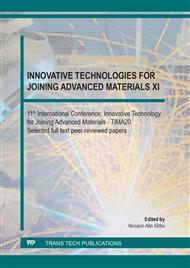p.56
p.66
p.76
p.82
p.95
p.105
p.120
p.141
p.147
Experiments on Friction Stir Processing (FSP), with Tilted Parent Metal
Abstract:
Friction stir processing (FSP), with tilted parent metal is a new process, which consists in the use of an inclined base plate with an angle α = 1 - 3 º related to the table of the FSP processing machine, by mounting a calibrated part under one end of the base plate. Two clamping plates are fixed with screws on the base plate, and a sheet (parent metal, PM) or a workpiece is placed between the base plate and the clamping plates. The processing tool has the same tilt angle with respect to the sheet to be processed. Said parts are components of the jig for the process described. The processing tool performs a movement with the speed v(x), correlated with a simultaneous movement with the speed v(z) = v(x) tg α. The correlation is achieved by means of a program developed for the processing machine. Due to the tilt, during the FSP process, the leading edge of the rotating tool shoulder progressively enters the PM, continuously, at the point where the shoulder penetration depth in the PM is minimal. On the multifunctional friction processing machine, MMPF type, the processing by the described process of an aluminium alloy sheet, with the sizes 300 mm x 200 mm x 4 mm was performed. A hardened C45 steel tool was used, having the following technical characteristics: shoulder diameter 14 mm, smooth frusto-conical pin with a large diameter of 2.5 mm, a small diameter of 2.0 mm, and a height of 1.5 mm. The parameters had the following values: tilt angle α = 2° 6'; pin penetration depth h = 1.60 - 1.85 mm; tool speed n = 1500 - 2000 rpm; speed v(x) = 1 - 2 mm / s; speed (software correlated) v(z) = 0.03672181 * (1 - 2) mm / s; the temperature of the sheet behind the tool t = 240 - 420 °C. The appearance of the processed sheet is appropriate. No imperfections are observed. The results are appropriate. The tilted PM brings the following advantages of the process: the mechanical stress to produce burrs and / or chips on the surface of the PM decreases; the way the FSP process is carried out is improved, by reducing gap moving and vibrations; the appearance and mechanical characteristics of the processed areas are improved; the quality level of the executed products rises; wear of processing tools is reduced; energy efficiency increases; the electricity consumption of the machine decreases; productivity increases.
Info:
Periodical:
Pages:
95-104
Citation:
Online since:
June 2021
Price:
Сopyright:
© 2021 Trans Tech Publications Ltd. All Rights Reserved
Share:
Citation:


